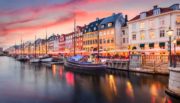Impressions of Denmark
Our visit to Copenhaguen last week was too brief for more than impressions, but enough to awaken greater interest in Denmark, the Danes and the history of Europe from the perspective of the northern Germanic peoples. Here are my notes on some of what I learned.
Denmark today is a small country but it was once the center of a vast empire and its people and culture have had outsize influence on world events, since even before their conquest of the half of Great Britain when it was under Dane Law from the 9th to 11th centuries. The Vikings raided and settled deep into Russia and across eastern Europeclear to Byzantium, where the Emperor’s élite guards were the big axe-wielding Norsemen called “Varangians”. In France, the Norsemen were known as Normands and under William would again conquer England in 1066. The defeated King Harold, at the head of the Anglo-Saxon defenders, was himself a descendant of Danes.
I was vaguely aware of all this from high school history courses, the movie “The Vikings”, research for my novel A Gift for the Sultan and other reading; walking upon the ramparts of the once-great fortifications around the kastell gave a new and more vivid sense of the smoke, fire, clamor and blood of the many wars against (at different times) the English, the Swedes and the Germans. The Nationalmuseum is the best place for a coherent narrative, with artifacts, representations and clear explanations of all this and much more, beginning with the earliest human settlements in the Stone Age on through the bronze and steel ages, Viking conquests and later colonial expansion and the slave trade, and on to the tragic story of the ill-fated Struensee (the museum displays what is supposed to be the axe that decapitated him in 1772), the social conflicts at the close of the 19th century that gave rise to the Social Democratic and Communist parties and the reconfiguration of the state as a constitutional monarchy. Denmark managed to stay at the margins of the first Great European War, 1914-18, but was seized and occupied by the Germans in the second great war. It is today one of the most prosperous countries in the European Union, though in 2000 its people voted against adopting the euro. Per capita income is reportedly over $50,000, the country is considered one of the least, or perhaps the very least, corrupt in Europe, and its citizens the happiest.
But Copenhaguen, the capital of this stable, well-ordered society with its balance of voices and parties preventing any great swing , contains two enclaves of silliness or disorder. In Christiania, a “free community” of hipsters and hash smokers and scruffy artisans, on a vast section of Christanshavn that was formerly a military installation, anyone can enter for free and wander among the sandaled, scruffy population with its colorful and grotesque signage and improvised improvements on the old military buildings. Across the city, right next to the Nationalmuseum, is Tivoli, a giant amusement park where any who can pay the price of admission can thrill to roller coasters, dizzying upside-down whizzing rides, fun and terror houses, and even spot of edenic gardens. These two curious enclaves, one openly commercial and the other supposedly anticapitalist, but both welcome alternatives to urban routine, are in both cases neatly contained: Tivoli by its walls and entry fees and Christiania by its canal separating it from the town center.
The great benefit of travel to new places is the stimulation of the imagination, to raise new questions and suggest new possibilities. This short visit has stirred my imagination, so that I will want to return to Denmark and its northern neighbors. Though the language will be a challenge. I managed to pronounce intelligibly a few phrases, but I plan to take the advice of an English woman and long-time resident of Denmark, which is to learn German first. It’s easier, and most of the words have the same roots — though with very different pronunciation.
